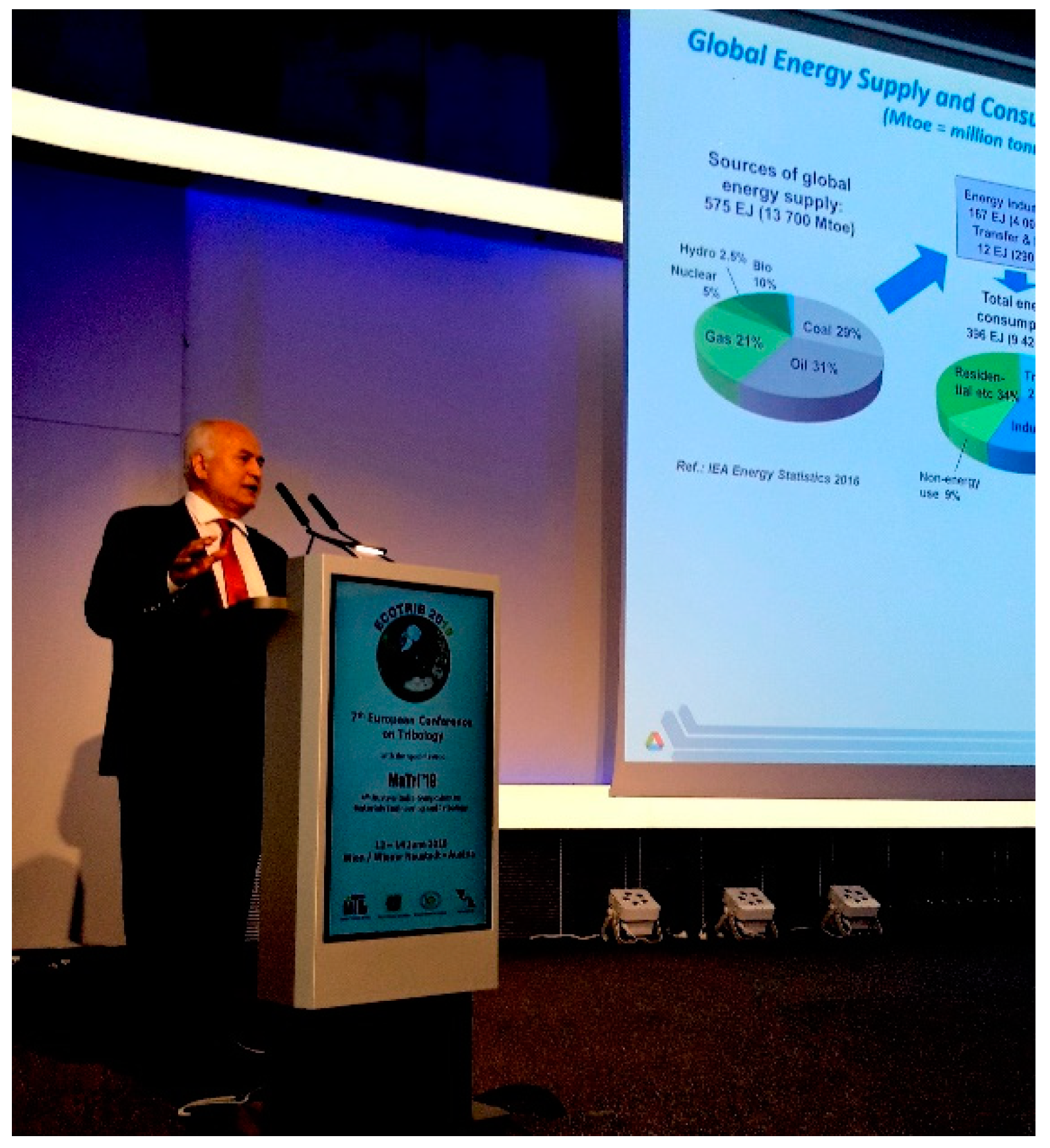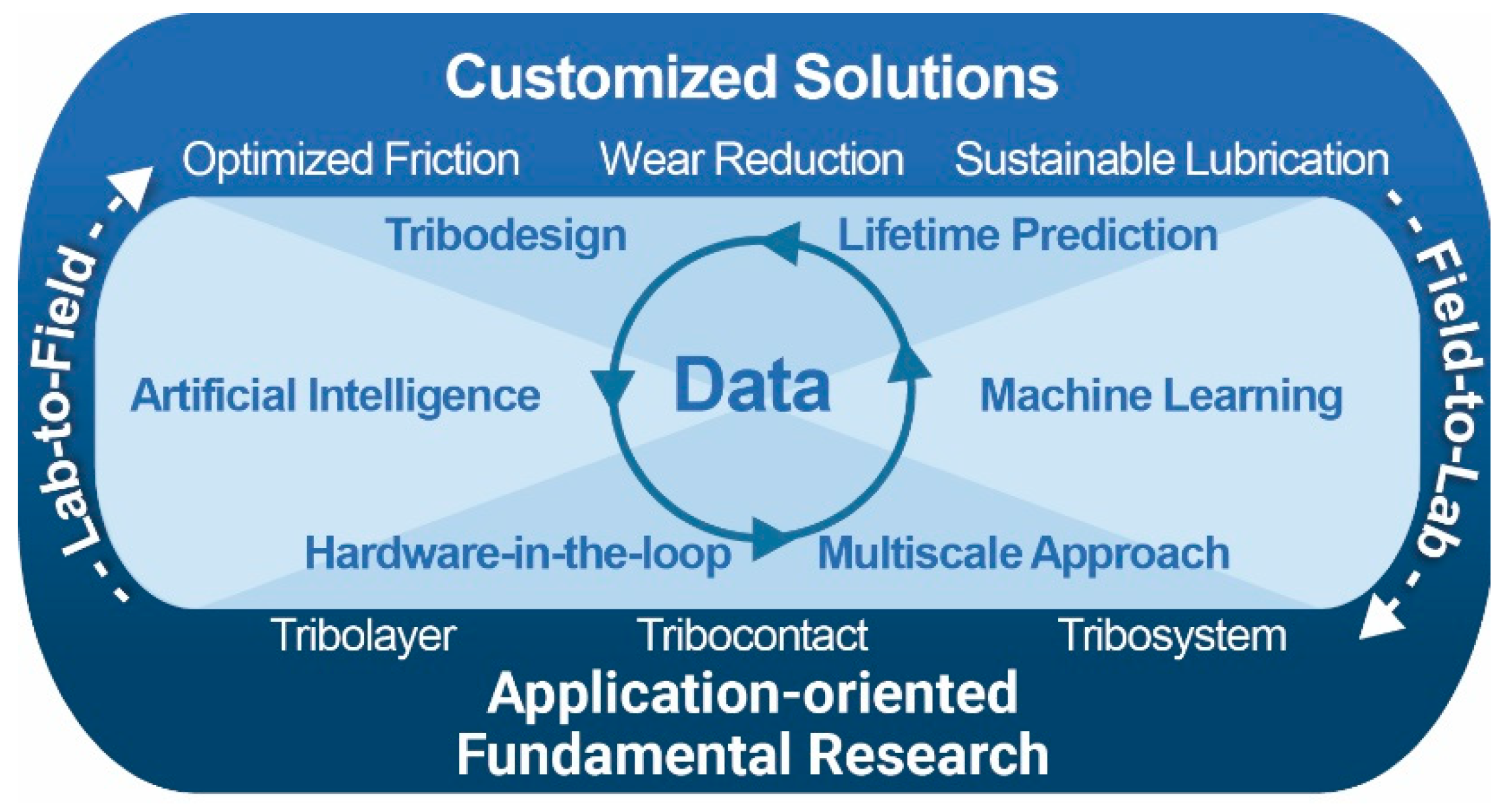Rethinking Tribology–Tracking Trends, Their Presence at the ECOTRIB 2019 Conference, and Their Impact on Tribology Research in Austria
Abstract
:1. Introduction
2. The Age of Changes—Including for Tribology
2.1. Tribology’s Position in Global Technology Trends
2.2. A Congress as a Reflection of Current Research Efforts
2.3. Tribology in The Age of Digitalization
3. “InTribology”—The New Austrian Tribology Research Program
3.1. Strategic Position of The Research Program
3.2. Research Areas
- Area 1: “Friction Optimized Devices” conducts research on customized surface and material design of energy-efficient and functional (mechanical) components, clearly focusing on reliability by a novel R&D approach viz. augmenting the field-to-lab/lab-to-field loop by a special view on tribosystems and the targeted application of data science.
- Area 2: “Wear Reduction Strategies for Industry” mainly deals with tribosystems under harsh environments, wear resistant materials, and monitoring and maintenance techniques. Ecological and economic sustainability are major concerns in the respective projects.
- Area 3: “Sustainable Lubrication” responds in its research to the current technological and ecological challenges of industrial applications, particularly, mobility. This Area–from a holistic point of view–pays special attention to designing future lubricants, lubrication, and maintenance concepts, essentially guided by “Green Tribology”.
- Area 4: “Synaptic Tribology” establishes the basis for the InTribology research program by adopting state-of-the-art methods of statistics and information technology and combining them with multiscale simulations, sophisticated experimental techniques and advanced chemical/physical analytical methods. This Area supports and complements the projects running in the other Areas and is responsible for the comprehensive application and method development of digitalization and data science in tribology.
3.3. Scheme and Objectives of InTribology Research
- Discovering correlations in data: Phenomenological approaches to predict friction and wear are not always available. New theories and models must be developed to go beyond the traditional way of data generation and interpretation. The capability of prediction using current tribological knowledge has to be extended by making use of modern data science, AI techniques—such as deep neural networks—and advanced sensor technology. Modern production processes are increasingly establishing condition-based and predictive maintenance; this significantly reduces machine downtime, and increases productivity and operational reliability. This requires customized sensors characterized by high robustness, low space requirements and low power consumption for the continuous measurement of critical properties (see Figure 3). Machine learning algorithms and statistical models help implementing ‘intelligence’ to predict behavior of tribosystems and thus of the reliability of the respective aggregates.
- Creating models from fundamental research: Data-driven knowledge goes beyond the current level of tribology. The additional knowledge enables the creation of novel tribological models or improve existing ones by combining them with well-established tribological principles. Parameter studies involving these models are performed for their verification and validation. For example, classical molecular dynamics provides insight into the behaviour of films between sliding surfaces that cannot be probed experimentally. Since the bonding between atoms, i.e., chemical bonds, are predefined here, chemical reactions of the lubricant with the surfaces cannot be captured. To overcome these limitations, reactive molecular dynamics simulations are performed using ReaxFF, one of the most used reactive potentials (cf. e.g., [17]).
- Simulating reality: Increased efficiency of machines such as vehicles and their components are challenging tasks for tribology research and development. New materials, new surface designs and lubricants are the key technologies to face this challenge. But state-of-the-art R&D processes for new materials and their application in tribological components and systems are very time consuming and costly. To accelerate the development a new approach based on “materials up-scaling” development environment is used. Down-scaling and up-scaling in tribology will be served by the introduction and implementation of such approaches for both industrial and academic challenges via developments of digital twins combined with experimental model tests and their characterization data. Tribological material behavior of a new material can be already predicted in a very early component development stage.
- Designing customized solutions: Customized solutions are built from reliable data correlations, fundamental models, and experimentally validated system performance. One such particular challenge is to functionalize components with light-weight structure; this may be fabricated from light alloy by 3D printing to increase wear resistance by embedding hard and wear resistant particles in a metallic matrix layer. Such coatings, along with self-lubricating phases for controlled friction behavior, can be fabricated using high power laser cladding. Furthermore, sensor integration in such hybrid components will allow online monitoring of tribologically relevant parameters or alerts, e.g., tension, pressure, friction forces. This way, the fields of application of those parts are considerably expanded.
4. Concluding Remarks
Funding
Acknowledgments
Conflicts of Interest
References
- Jost, H.P. Opening Address. In Proceedings of the 20th International Colloquium Tribology—Industrial and Automotive Lubrication, Technische Akademie Esslingen—TAE, Stuttgart/Ostfildern, Germany, 12–14 January 2016. [Google Scholar]
- Hasegawa, T. (Ed.) Tribology Research Trends; Nova Science Publishers, Inc.: Hauppauge, NY, USA, 2008. [Google Scholar]
- Holmberg, K.; Andersson, P.; Erdemir, A. Global energy consumption due to friction in passenger cars. Tribol. Int. 2012, 47, 221–234. [Google Scholar] [CrossRef]
- Spencer, N.D. The Cutting Edge of Tribology, a Decade of Progress in Friction, Lubrication, and Wear; World Scientific: Singapore, 2015. [Google Scholar]
- NN. 12 Disruptive Business and Technology Trends for 2020, (TNXTOutlook 2020, The Next Organization, NL). Available online: https://www.consultancy.eu/news/4000/12-disruptive-business-and-technology-trends-for-2020 (accessed on 3 May 2020).
- Briggs, B.; Buchholz, S. Deloitte Insights—Tech Trends 2020. Available online: www.deloitte.com/insights/tech-trends (accessed on 3 May 2020).
- Müller, J.; Potters, L. Future Technology for Prosperity—Horizon Scanning by Europe’s Technology Leaders; European Commission: Brussels, Belgium, 2019; ISBN 978-92-76-09509-5. Available online: https://op.europa.eu/en/publication-detail/-/publication/ae785b63-dba9-11e9-9c4e-01aa75ed71a1/language-en/format-PDF/source-116042367 (accessed on 24 July 2020).
- NN. Report on Emerging Issues and Trends in Tribology and Lubrication Engineering; STLE—Society of Tribologists and Lubrication Engineers: Park Ridge, IL, USA, 2017. [Google Scholar]
- Woydt, M.; Gradt, T.; Hosenfeldt, T.; Luther, R.; Rienäcker, A.; Wetzel, F.-J.; Wincierz, C. Tribologie in Deutschland—Querschnittstechnologie zur Minderung von CO2-Emissionen und zur Ressourcenschonung; GfT—Gesellschaft für Tribologie e. V.; DE: Jülich, Germany, 2019; Available online: https://www.gft-ev.de/wp-content/uploads/GfT-Studie-Tribologie-in-Deutschland.pdf (accessed on 24 July 2020).
- Reynvaan, C. Trends in Tribology Discovered by a Sematic Big Data Analysis, Proceedings, ÖTG Symposium 2917; Austrian Tribology Society (Österreichische Tribologische Gesellschaft—ÖTG): Wiener Neustadt (AT), Austria, 2017; ISBN 978-3-901657-56-6. [Google Scholar]
- Duh, A.; Korošak, D. Percipio Big Data Analytics Software, Version 2017. Available online: https://percipio-big-data.com/#about (accessed on 29 April 2020).
- Franek, F.; Dörr, N.; Badisch, E.; Jech Vernes, A. An Advanced View on Tribosystems: TriboTope Approach, Supplementary Presentation. In Proceedings of the ECOTRIB 2019—7th European Conference on Tribology, Vienna (AT), Austria, 12–14 June 2019; Österreichische Tribologische: Wiener Neustadt (AT), Austria, 2019. [Google Scholar]
- Dörr, N.; Gachot, C.; Franek, F.; Kalin, M.; Ciulli, E.; Crockett, R. (Eds.) Book of Abstracts, ECOTRIB 2019—7th European Conference on Tribology with the Special Event MaTri ‘19—4th Austria-India-Symposium on Materials Engineering and Tribology, Vienna (AT), Austria, 12–14 June 2019; Österreichische Tribologische Gesellschaft (Austrian Tribology Society): Wiener Neustadt (AT), Austria, 2019; ISBN 978-3-901657-60-3. [Google Scholar]
- COMET—Competence Centers for Excellent Technologies, The Austrian Research Promotion Agency (FFG). Available online: https://www.ffg.at/en/comet-competence-centers-excellent-technologies (accessed on 4 May 2020).
- “The European Green Deal”, Communication from the Commission to the European Parliament, the European Council, the Council, the European Economic and Social Committee and the Committee of the Regions. Available online: https://ec.europa.eu/info/sites/info/files/european-green-deal-communication_en.pdf, cf. https://en.wikipedia.org/wiki/European_Green_Deal (accessed on 15 May 2020).
- Badisch, E.; Dörr, N.; Pirker, F.; Franek, F.; Pauschitz, A. Customized Tribology for Industrial Innovations: InTribology—Research Perspectives 2020–2028, Proceedings, p. 11–18, ÖTG-Symposium 2019 “Tribology in Industry and Research—Tribology Impulses through Digitalization?”, Dornbirn (AT), Austria, 21 November 2019; Österreichische Tribologische Gesellschaft (Austrian Tribology Society): Wiener Neustadt (AT), Austria, 2019; ISBN 978-3-901657-62-7. [Google Scholar]
- Mohammadtabar, K.; Eder, S.J.; Bedolla, P.O.; Dörr, N.; Martini, A. Reactive Molecular Dynamics Simulation of Thermal Film Growth from Di-tert-butyl Disulfide on a Fe(100) surface. Langmuir 2018, 34, 15681–15688. [Google Scholar] [CrossRef] [PubMed]



| Session | No. |
|---|---|
| Fundamentals of tribology | 22 |
| Biotribology | 14 |
| Lubricants & Lubrication | 14 |
| Materials, coatings & thin films | 14 |
| Modelling & simulation | 13 |
| Tribology in machine elements | 12 |
| Reliability & condition monitoring | 11 |
| Tribosensorics | 11 |
| Smart material | 7 |
| Corrosive environment | 5 |
| Tribocorrosion | 4 |
| Tribology in transportation | 4 |
| Tribology in production process | 3 |
| Total presentations | 134 |
© 2020 by the authors. Licensee MDPI, Basel, Switzerland. This article is an open access article distributed under the terms and conditions of the Creative Commons Attribution (CC BY) license (http://creativecommons.org/licenses/by/4.0/).
Share and Cite
Franek, F.; Dörr, N.; Badisch, E.; Pauschitz, A. Rethinking Tribology–Tracking Trends, Their Presence at the ECOTRIB 2019 Conference, and Their Impact on Tribology Research in Austria. Lubricants 2020, 8, 80. https://doi.org/10.3390/lubricants8080080
Franek F, Dörr N, Badisch E, Pauschitz A. Rethinking Tribology–Tracking Trends, Their Presence at the ECOTRIB 2019 Conference, and Their Impact on Tribology Research in Austria. Lubricants. 2020; 8(8):80. https://doi.org/10.3390/lubricants8080080
Chicago/Turabian StyleFranek, Friedrich, Nicole Dörr, Ewald Badisch, and Andreas Pauschitz. 2020. "Rethinking Tribology–Tracking Trends, Their Presence at the ECOTRIB 2019 Conference, and Their Impact on Tribology Research in Austria" Lubricants 8, no. 8: 80. https://doi.org/10.3390/lubricants8080080




